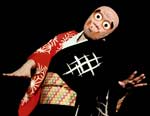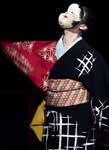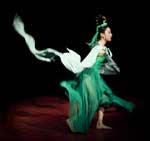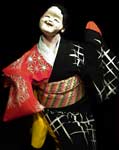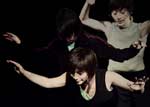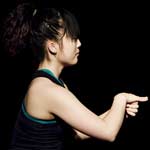 |
| Asia: Collection of Artists |
|
| March 20, 2005 • Lula Lounge • Toronto |
|
|
|
|
|
|
| On Sunday evening, Toronto's Lula Lounge became the friendly venue for Asia: Collection of Artists, an impressive showcase of Asian dance and music. |
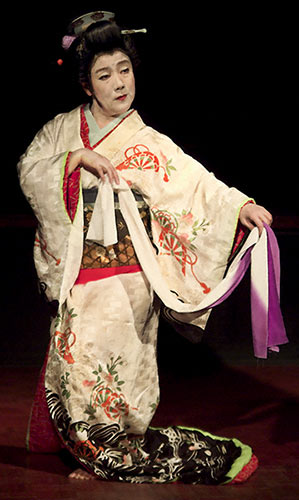
Hanayagi Hirokoma |
|
In front of the stage, the floor was spot lit, and classical piano music played softly from the speakers as we took our seats. It was calm in the club.
This air of calm continued as a Japanese woman (Hanayagi Hirokoma) appeared in a red and white kimono. She sat silently at a small table under the spotlight and began to apply white makeup evenly onto her face, neck, and hands. I started wondering if this was a piece of concept art happening right in front of us.
Hana Watanabe, the young MC and organizer, then appeared on stage and announced that Ms. Hirokoma was putting on makeup for her dancing role, and we were free to ask questions. Thanks to Hana's simultaneous translation, the dancer was able to speak to us about her dances.
Ms. Hirokoma was clearly a traditional Japanese dancer because her makeup and wardrobe were in the traditional colour range: white face and hands, black dashes for eyebrows, red lips, and a helmet-like hairpiece of jet-black hair.
A graphic portrait of a geisha (professional entertainer). An example of Japanese visual genius which distills experience into clear shapes and colours such as red, white, and black, and frequently combines and recombines these dominant colours into an articulate, versatile expression.
|
|
|
Think of red and white as it appears in the wardrobe and makeup of Kabuki and Noh traditional theatre. Think of red and white as it appears in onigiri (rice ball), a simple snack with a red plum in its centre. Think of red and white as it appears in Japan's flag, a red ball (sun) on a white field. Red, white, and black resonate from the Japanese core.
Ms. Hirokoma's first piece was set after a rain shower and was danced with a naturalistic feeling and considerable vulnerability. In the second piece, her changing emotions could be seen in the movements of her hand-held fan.
Speaking of fans, the next dancer, Jen-Yi Hum, really knows how to crack a fan in her dances that highlight the dramatic and highly athletic aspects of Chinese classical dance.
|
|
Jen-Yi Hum is striking in appearance. Her body swoops into dramatically held still poses, she is battle-ready in green silk trousers and green silk top, and the two fans she snaps open contrast strikingly (and in a charming way) with the very different belly dancing that followed from the Arabesque Dance Company.
We're parachuted right into the Middle East, in Asia Minor, where dances celebrate the voluptuous female body. The jumping fringed gold tops and gold skirts, the coloured scarves held up high when turning, the defined hand and arm movements, this is celebratory dance, I see the eyes! but we're always brought back to the shaking and undulating parts of the three attractive women in front of us. The music wails. Amazing.
|
|
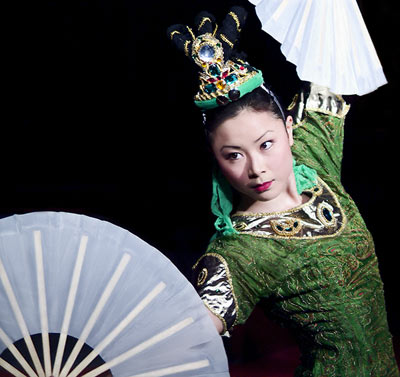
Jen-Yi Hum |
|
|
The pace slowed down as we listened to Gurpreet Chana, a masterful tabla (hand drum) player whose left hand (bass) and right hand (treble) played independently and in lucid dialogue with each other. Gurpreet next delighted us by playing a percussion instrument that resembled a Chinese wok with a lid. His music fluently mixes the sound of other cultures with his own South Asian roots, and under his fluttering hands, as he took us into Intermission, Gurpreet's melodies had the sound of sweetly chiming steel drums.
For a real change of pace, The Pianoman was thrown up on a big screen. The Pianoman is a short colour animation by Hiroyuki Yabu, a young animator who's pursuing further studies in Vancouver. Yabu's 3-D computer modeling and drawing skills were highly evident, and as we grooved to the hard bop soundtrack, we said we'd look out for his future work.
Next up: Green Tea Dance Collective, a gathering of seven Japanese-born dancers who are 15-year veterans of the Toronto contemporary dance scene. I recognized the names of two of the dancers, Naoko Murakoshi and Keiko Ninomiya. Excellent.
The Green Tea emphasis is on the group. With their backs turned to us, all seven dancers silently gesture 'Kampai' ('cheers' in Japanese) and raise their teacups. Their heads turn right, their right arms hold out cups. They turn clockwise to face us, their faces relaxed. The teacups are inverted and shown to be empty. Now and then a member passed through a human archway to once again rejoin the group. This is danced at a medium tempo.
In this piece, Green Tea embodied the group concept, the collective, the harmonious working together in order to live. They have therefore re-engaged with their traditional Japanese roots while dancing in the open modern dance style of Martha Graham, a style that is the opposite of classical ballet. In the Green Tea troupe, and in the Graham 'style', the dancer's moves are mostly floor-bound, and as the body explores the dancing area with swift and slow paces, unwound circlings and outbursts of running, the gap between dancing and acting is closed. The music for this piece is 'cricket-like', mid-register electronic, and quietly unsettling.
Hanayagi Hirokoma returned with a brief dance in which she alternated between wearing the full-face mask of a woman, and the mask of a bug-eyed and possibly tipsy man. We loved it. No interpretation was needed as she concluded this comical dance. Her pictures spoke volumes.
And now for the headliner, the featured guest artist.
|
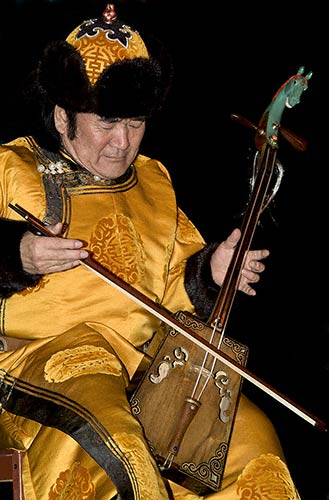
Chi Borag |
|
Chi Borag blew us out of the water. The deep and ancient sounds of his 2-string bowed Mongolian cello (Morin Khuur) were all about commitment to the moment and the story: the history of the Mongolian people and their struggles to retain their culture and way of life; the evocation of a beloved river; and the sense of the wide open dry plains that thousands of horses freely gallop over. Chi Borag's impassioned playing took us to those places.
Mr. Borag is also a composer and an expert in Mongolian folk music and folk art. He is considered Mongolia's National Human Treasure for his instrument, Morin Khuur, and is scheduled to perform with an orchestra of 2,008 musicians at the Opening Ceremonies of the Olympics in Beijing, China, in the year 2008.
On this particular evening, it was Chi Borag who contributed a deep sonic baseline to the whole evening of diverse and rich artistic performances; and it was Hana Watanabe, whose enthusiasm and organizing skills turned Lula Lounge into a great space for Asian talent.
I see this evening as a preliminary warm-up to the entire month of May, which is Asian Heritage Month. Keep an eye open: there'll be a lot more art and culture to appreciate during Asian Heritage Month in Toronto. Guaranteed.
|
|
|
|
|
Click on thumbnails to view larger photo
|
|
|
|
|
|
|
|
|






